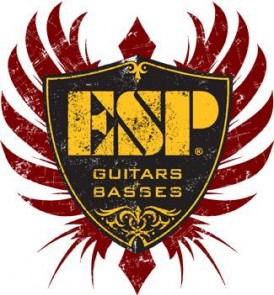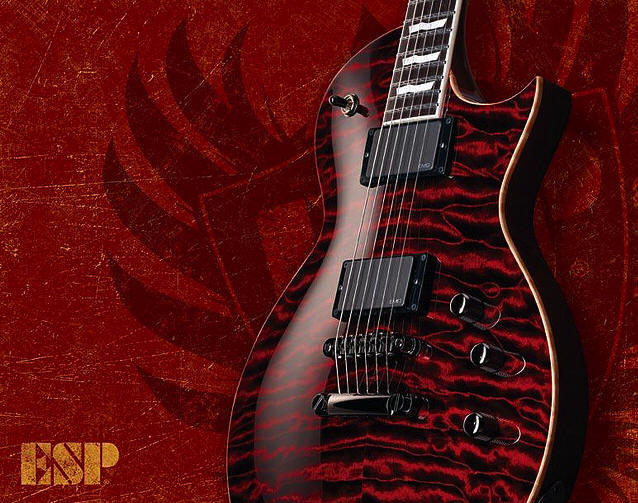In 1975, Hisatake Shibuya opened a
shop called Electric Sound Products (ESP) in Tokyo.
It provided custom replacement parts for guitars. In
1976, ESP gained a reputation as a provider of
high-quality replacement parts. At this time, ESP
also began crafting guitars under the ESP and
Navigator brand in the Japanese market..
ESP replacement parts were first introduced into the US in 1983. ESP began crafting custom instruments for local New York artists between 1984 and 1985. Among these artists were Page Hamilton (Helmet), Vernon Reid (Living Colour), Vinnie Vincent & Bruce Kulick (KISS), and Ronnie Wood (The Rolling Stones). At this time, ESP also introduced the 400 Series as the first production line distributed in the US.
During this same period of time, ESP began making
the bodies and necks for Kramer Guitars. Other
manufacturers using ESP as an OEM were Robin
Guitars, Schecter Guitar Research and DiMarzio. Many
traits of the Kramer line are still visible
including neck construction and body bevels. ESP
tooled up for Tom Anderson's shaved bolt on neck
heel on the Schecter bodies, and has since become a
feature of their house brand.
In 1986, George Lynch discovered ESP while on tour
in Tokyo. Lynch walked into an ESP shop looking for
a replacement neck and learned that ESP also built
custom guitars. As a result, his famous ESP Kamikaze
was made. ESP soon introduced the M1 Standard, MI
Custom, Horizon Custom, and the Surveyor bass into
the market.[citation needed]
At this time, ESP released George Lynch's Kamikaze
as its first signature model. ESP based its
headquarters in a loft in downtown New York City on
19th Street. In 1989, the headquarters were moved to
48th Street near the famous music stores.
Between 1990 and 1992, ESP expanded its Signature
Series as well as its standard product line. The US
replacement parts business was discontinued in order
to switch focus solely on the guitar and bass line
as well as the custom shop. There are about 41
signature series guitars.
In 1993, ESP moved its headquarters again but this
time it was relocated to Los Angeles. There, ESP
opened an office on Sunset Blvd. in Hollywood. In
1996, LTD was created to produce ESP's high-quality
products in a more affordable line of production.
Soon after the introduction of the Korean and
Indonesian-made LTD lines, ESP discontinued selling
the majority of its Japanese-made flagship
instruments in the United States due to the prices
involved in exporting to the Americas. The lone
exception was ESP's artist signature lines, which
remained ESP (rather than LTD) models. In the early
2000s, ESP resumed shipping the standard
Japanese-manufactured lines to the United States
(where they are very popular among metal and hard
rock players), albeit at greatly increased prices
compared to the early 90s..
ESP was initially known for making high quality and
customized replicas of famous American guitars,
including hot rodded Fender Strats and Teles, as
well as Gibson Explorers. The latter model (known as
the EXP/MX) shot to fame when avid ESP user James
Hetfield's band Metallica became extremely popular
in the late 80s/early 90s. Models similar to
Hetfield's black ESP even today sell for hundreds of
dollars beyond the original retail price. However,
just like Ibanez, when the Gibson company realized
the extent to which ESP was denting into the sales
of its own guitars, it filed a suit to prevent the
sales of these guitars in the Americas and ESP
redesigned its lines to be less similar to the
American models.
In 2002, ESP was ranked among the music industry's
fastest growing companies. This is largely due to
the Fender buyout of Jackson Guitars, with whom ESP
had struggled to compete throughout the 1980s and
1990s. With the buyout, many Jackson endorsers
switched over to ESP, due to their stunningly
similar design, playability, and quality of their
guitars and basses (this has ignited a feud between
players, with Jackson players citing ESP as inferior
and copy instruments, while ESP players say the same
about Jackson). Some of these artists who left
Jackson for ESP included Dave Mustaine (Megadeth),
Adam Darski (Behemoth), Alexi Laiho and Roope
Latvala (Children of Bodom), Dan Jacobs and Travis
Miguel (Atreyu), Galder and Silenoz (Dimmu Borgir).


